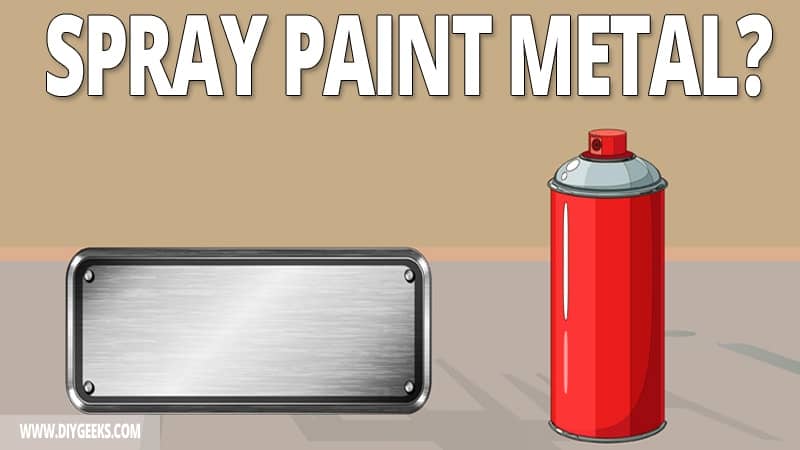You can spray paint metal but its surface must be properly cleaned, sanded, and primed to get rid of dust, debris, and rust on it.
To spray paint metal, scrape the existing finish off, sand the surface, apply primer, and apply the spray paint.
Use spray paint designed for metal surfaces as they are formulated with extra additives to improve the adhesion and help the finish last longer.
For outdoor metal surfaces, seal the finish with a moisture-resistant and rust-proof sealer to prevent the surface from turning brown.
Do Spray Paints Adhere to Metal Surfaces?
Spray paints don’t adhere properly to metal surfaces, especially to bare metal. Spray paint adheres initially over them, but the finish peels off after a few weeks.
Bare metal surfaces are slick and non-porous, so the Spray paint can’t penetrate or stick to it.
Also, metal surfaces are riddled with grime, dirt, and rust (especially outdoor surfaces). These elements will prevent a good adhesion, so you must clean, sand, and prime the surface first.
Cleaning and sanding will remove dirt, dust, and imperfections, while primer will produce a dry textured finish that will cover the slick surface of the metal and improve the adhesion of the paint.
It’s advised to use a self-etching primer as it will corrode the metal surface making it easier for the spray paint to stick.
Which Spray Paint Types Can You Use Over Metal?
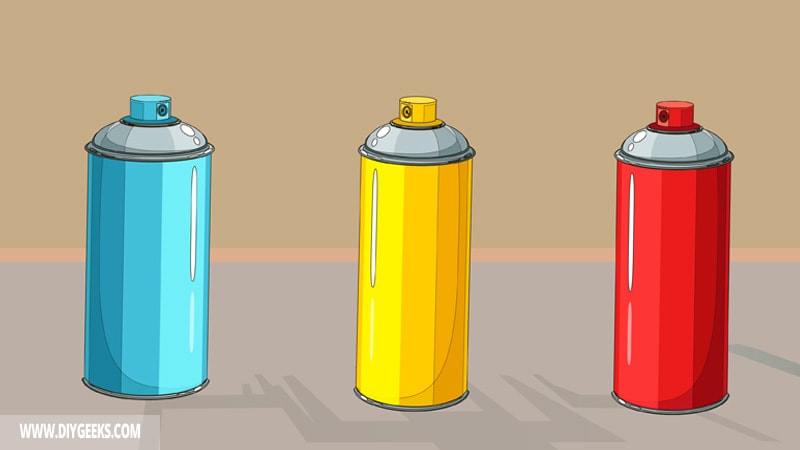
You can use oil-based enamel Spray paint over outdoor metal surfaces as it’s durable, water-resistant, and protects the surface from moisture and rust. But, they take longer to dry since the finish is oil-based.
You can use water-based acrylic Spray paint for indoor metal surfaces as it produces a bright (colorful) finish.
For slick metal surfaces, use Rust-oleum or Krylon, as they are specially made for metal and are formulated with a primer coating, so you don’t need to apply an extra one.
Rust-oleum spray paint is formulated with silicone compounds that protect surfaces from heat and UV rays.
Note: Avoid using Spray paints with poor water-resistant qualities as they won’t protect the surface and will expose it to different elements.
How To Spray Paint Metal?
To Spray paint metal, do the following things.
- Scrape the Existing Finish Off.
- Sand the Surface.
- Apply Primer.
- Apply the Spray Paint.
The tools you need for this project are listed below.
- Clean rags
- Medium and fine-grit sandpaper
- Scraper
- Safety gear
- Drop sheet
- Tape
- Paint shield
- Primer
- Spray Paint
1. Scrape the Existing Finish Off
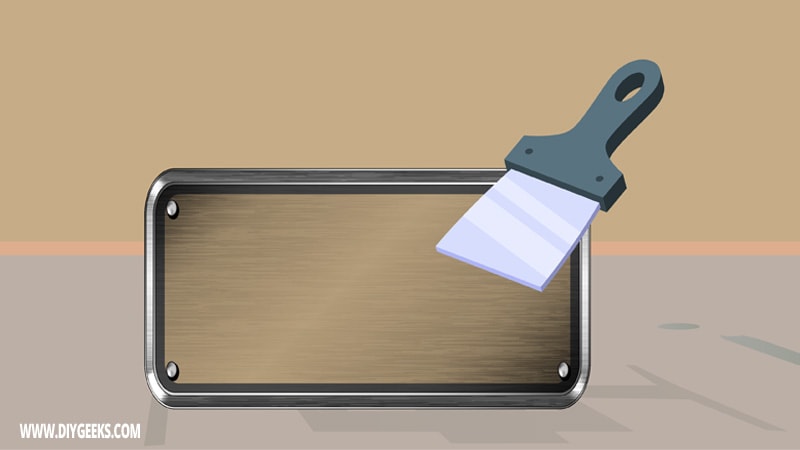
Remove the existing metal surface finish as it prevents a new paint from adhering, and can discolor the new finish.
To remove a paint finish from the metal surface, use a paint-stripping paste. The paint-stripping paste penetrates the paint finish, dissolves the binder, and liquefies the finish.
Ensure to clean the metal surface with soapy water to remove the paint-stripping paste residue from the surface.
2. Sand the Surface
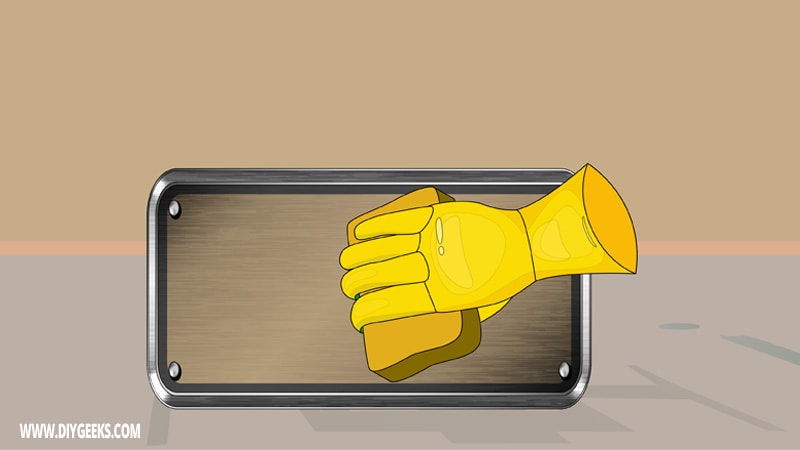
Sand the metal with medium-grit sandpaper (100-grit) to remove imperfections and rust from the surface and create a textured layer for the new paint to stick to.
Ensure to sand the corners and nooks of the surface, too. For hard-to-reach spots, use a folding sanding sheet.
Clean and wipe the surface thoroughly after sanding.
3. Apply Primer
Apply two (2) self-etching primer coats over the metal surface using a paintbrush, roller, or sprayer. The primer covers the existing finish and creates a dry textured coating that enhances the spray paint penetration and adhesion.
4. Apply the Spray Paint
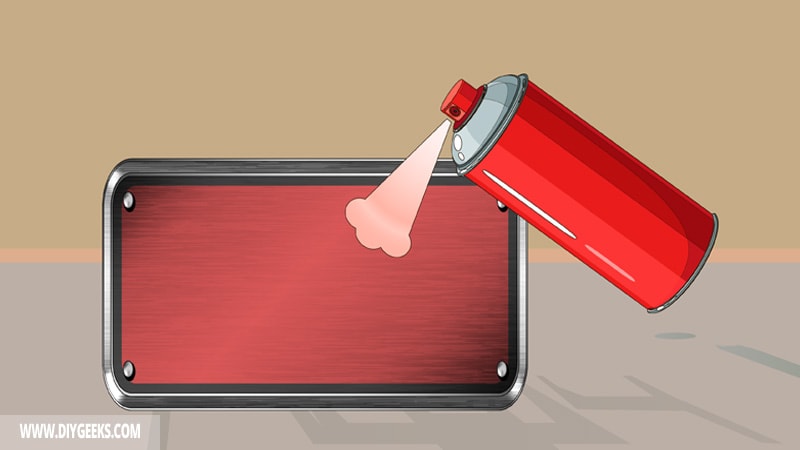
Apply three (3) spray paint coats over metal surfaces. Wait until one coat dries, wipe the excess, and apply the new coat. Spray paint takes around 1-4 hours to dry between coats.
If you are using spray paint (can), shake the can so the content inside can be properly mixed. If you don’t, the coating won’t have an even consistency or color.
Thin the paint if you are using a spray gun as most paints are too thick to fit the sprayer’s nozzle. While spraying, keep at least 8 inches between the nozzle of the sprayer and the surface. Also, you should spray in a sweeping motion to prevent applying thick coats.
Seal the spray paint finish with a moisture-resistant sealer to increase its durability and protect it from water, moisture, scratches, and weather elements. Exterior polyurethane or spar varnish are a great choice.
How To Prevent Spray Paint Blisters?
To prevent Spray paint blisters, do the following things.
- Don’t over-shake the spray can.
- Clean the surface.
- Remove rust.
- Allow enough dry time.
1. Don’t Over-shake It
You must shake the Spray paint can before applying it to mix the content, but you shouldn’t over-shake it as it will create bubbles inside it. The bubbles will create blisters in the finish, so it’s best to avoid them.
To prevent bubbles in the can, shake it lightly for less than 60 seconds.
2. Clean The Surface
Blisters will form if the surface is riddled with debris and dust. To prevent them, clean the surface properly before painting it.
3. Remove Rust
Rust will produce blisters once the coating starts to dry. To prevent it, remove rust from metal by scraping and sanding its surface, or by using a rust-removal product (if there’s too much rust).
4. Allow Enough Dry Time
The finish will develop blisters if you re-coat it too soon as the moisture will trap between the underneath coat. On average, a coating dries within 30-60 minutes over a metal.
How To Prevent a Spray Paint Finish from Chipping Off?
To prevent the Spray paint finish from chipping off, do the following things.
- Prep The Surface – If you don’t clean the surface it will be filthy, and the filth will prevent good paint adhesion. Since the spray paint won’t stick well, it can easily chip off the surface.
- The Type – Not every type of spray paint can be used on metal. If you use a coating that has no moisture or rust resistance, the finish will be quickly affected by moisture and it can peel and chip off.
- Dry Time – If you re-coat too soon, the next coating won’t stick well so it can peel off. During high-humid conditions, you must wait 2 times more for the coating to dry than normal.
- Thick Coats – If the coating is too thick, it can develop cracks that will cause it to peel off gradually.
- Fast Dry Time – If the finish dries too fast, the particles don’t have enough time to harden and compact so the finish will peel off.
FAQ’s
Can You Spray Paint over Painted Metal?
You can Spray paint over painted metal, but you shouldn’t as the existing finish is usually oil-based and will prevent a new coating from sticking. An oil-based finish is usually moisture-resistant, so the new coating won’t stick anyway.
Remove or sand the existing finish first before painting over it.
How Long Will Spray Paint Last on Metal?
Spray paint will last 5 years on metal before you notice any imperfections or changes in the finish, on average.
The finish lasts long as spray paints designed for metals are oil-based and have moisture-resistant features that will protect the finish under harsh conditions.
[su_youtube url=”https://www.youtube.com/watch?v=nNKzOm7DS_k”]
[sc name=”spray-paint-metal”][/sc]
